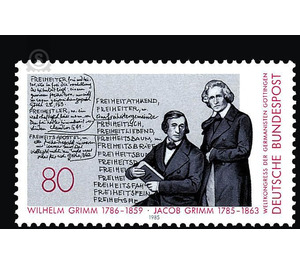200th birthday of the Brothers Grimm - Germany / Federal Republic of Germany 1985 - 80 Pfennig
Theme: Calender
| Country | Germany / Federal Republic of Germany |
| Issue Date | 1985 |
| Face Value | 80.00 |
| Color | grey |
| Perforation | K 14 |
| Printing Type | 3-color offset |
| Stamp Type | Postage stamp |
| Item Type | Stamp |
| Chronological Issue Number | 1109 |
| Chronological Chapter | GER-BRD |
| Michel ID | BRD 1236 |
| SID | 509196 |
| In 53 Wishlists | |
200 years ago, on January 4, 1785 and on January 24, 1786, the linguists and literary scholars Jacob and Wilhelm Grimm were born in Hanau. Wilhelm Grimm died on December 16, 1859, Jacob on September 20, 1863, both in Berlin. The Brothers Grimm are considered the founders of Germanic philology. As scientists, they soon and internationally gained international prestige. They were highly regarded, active members of a number of scientific academies and learned societies in Germany and abroad. Jacob Grimm was a winner of high honors, he became in 1842 a member of the Order Pour le mérite for Sciences and Arts. Taking up the suggestions of Johann Gottfried Herder, they were, together with Ludwig Achim von Arnim and Clemens Brentano, discoverers and editors of the literary traditions traditionally transmitted orally: folk songs, folk tales and legends. During their law studies in Marburg from 1802 to 1805 and 1803 to 1806 they were influenced in their scientific interpretation by their academic teacher Friedrich Carl von Savigny sustainable and later applied for the first time the historical method developed for jurisprudence on the linguistics and literature. They combined their approach with comprehensive source studies and strict source criticism. In this way, also in the philological field of the thorough and always verifiable proof of evidence emerged. On this basis, works of her kind appeared in exemplary fashion during her life. Legal history, text editions of medieval literature, grammar, religious studies and history are the sciences to which Jacob Grimm devoted himself in particular; as published results of his research are called (in selection): German Rechtsaltertümer (1828); Reinhart Fuchs (1834); Silva de romances viejos (1815); Andreas and Elene (1840); German Grammar (1819/1822 - 1837); German mythology (1835); an edition of Germania (1835) by Publius Cornolius Tacitus. Wilhelm Grimm also published medieval texts, so together with his brother Jacob the Hildebrandlied (1812, facsimile 1830) and - alone - Old Danish heroic songs (1811); Konrads of Würzburg Golden Forge (1850); Count Rudolf (1828 and 1844); Freidank's modesty (1834); Konrad's of the Pfaffen Rolandslied (1838); Exhortatio ad plebem christianam. Glossae Cassellanae (1848); but also of the friend Ludwig Achim von Arnim Alle Werke (1839 - 1856). His work On German Runes (1821), which marks the beginning of scientific runic research in Germany, also testifies to his thorough grammatical-linguistic knowledge, which has been repeatedly proven in text editions. As a last, again common work, the Brothers Grimm began the publication of their extensive German Dictionary (1854 ff.), The 1960, so more than a hundred years later, as a collaborative work of the Academic Academy in Berlin and Göttingen with a total of 32 volumes of A - Z has been fully submitted. In a sense, this reflects a first collaboration of their youth: the edition of the two-handed edition of Children's and Household Tales (1812-1815), collected by them and edited in their versions, in a volume of 156 fairy tales increase the output last hand (1857) and could multiply by 10 child legends. With her comments on the fairy tales (1819) began the now internationally widespread fairy tale research. The special postage stamp is also related in content to the VII Congress of the International Association for Germanic Language and Literature, which takes place from 25 to 31 August 1985 in Göttingen; In the spirit of the Brothers Grimm, he wishes to bring the linguists and literary scholars of all Germanic philologies together for common endeavors and to deal with older, but always significant, controversies or open and deliver new ones. The motif shows a double portrait of the Brothers Grimm after a steel engraving by Lazarus Gottlieb Sichling. The engraving was made after a photograph by Hermann Biow and added by the publisher to the first volume of the German Dictionary (1854) as an author's portrait. The text lines are contained in the printed manuscript of Jacob Grimm for the German dictionary (4,1,1,113) to the word complex freedom. (Text: Brothers Grimm Museum Kassel - Dr. Dieter Hennig)
| Condition | Name | In Stock | Price | Price + Shipping | Store | |
|---|---|---|---|---|---|---|
 | Unmounted Mint ** | 200th birthday of the Brothers Grimm - Germany / Federal Republic of Germany 1985 - 80 Pfennig | 10 | US $0.961 | US $4.15 |  FILATELIELOKET (0) FILATELIELOKET (0)Shipping US $3.19 Minimum Order US $2.67 |


